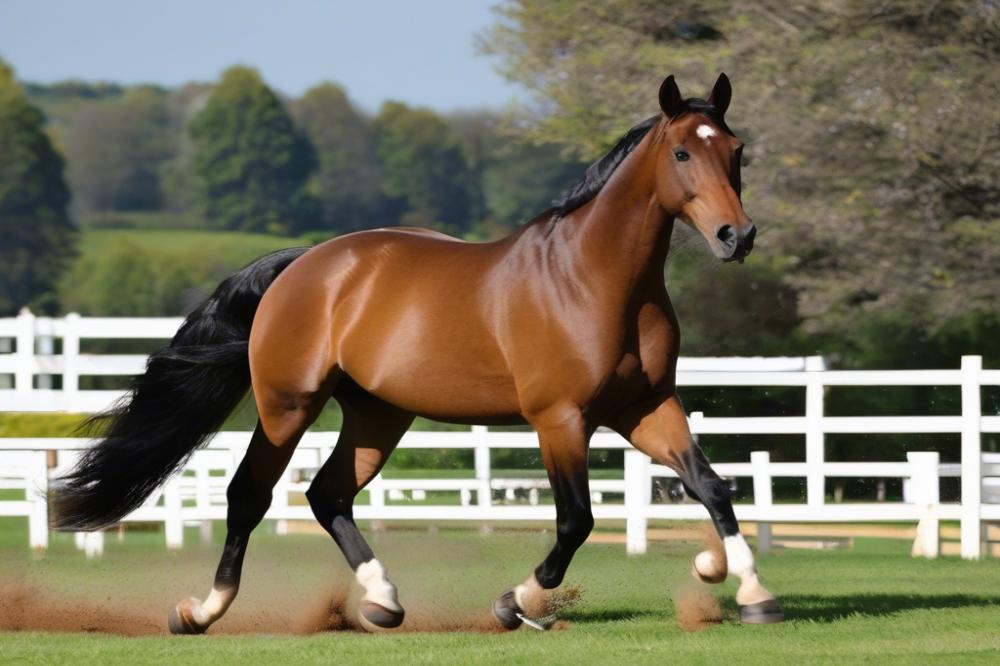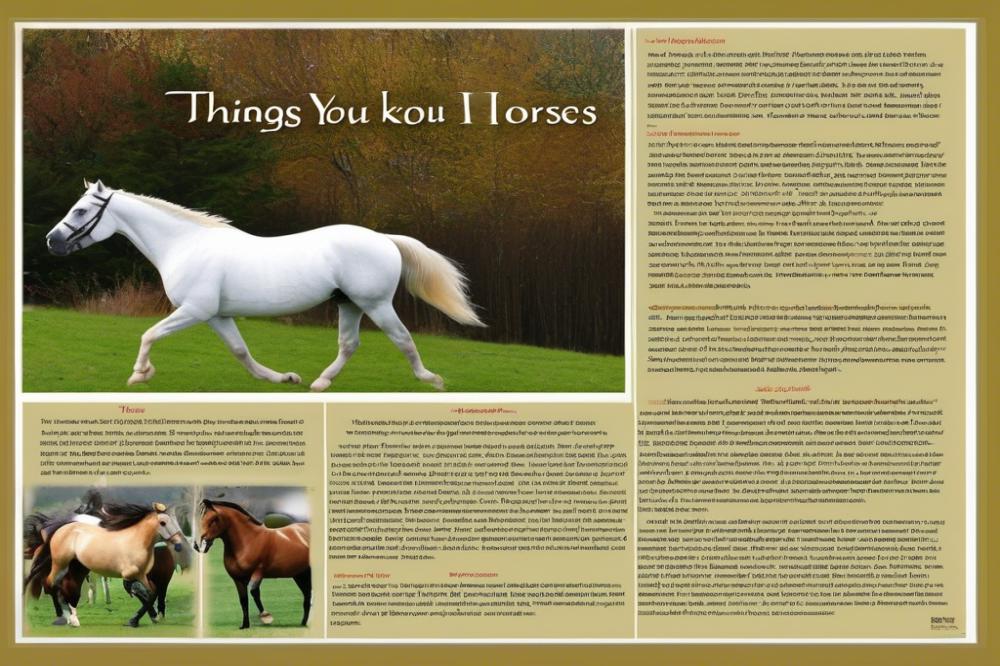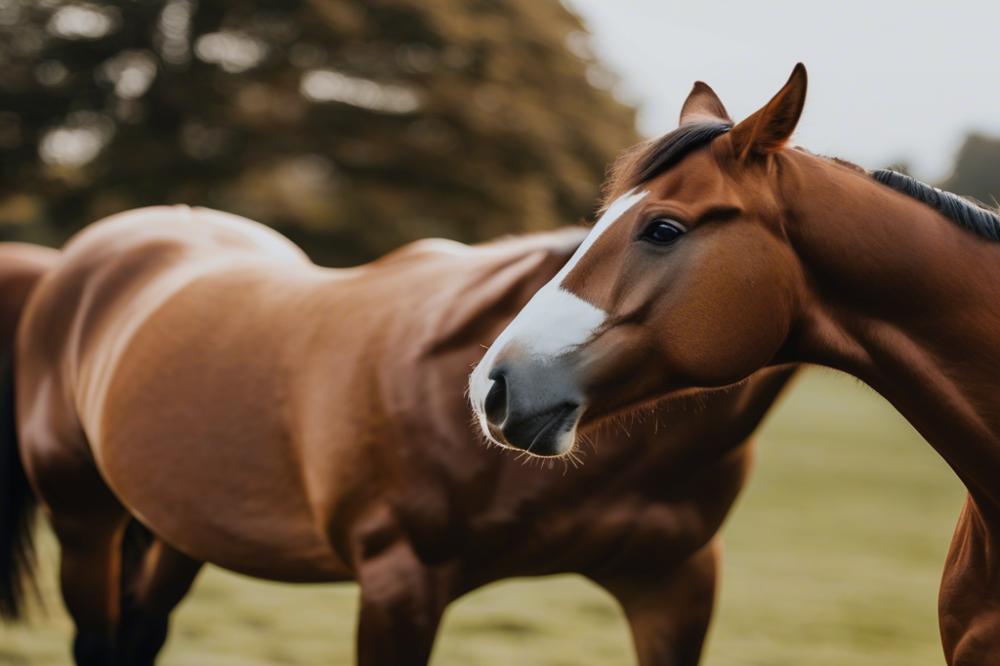Understanding Horses: A Journey Through Time
Have you ever wondered how horses came to play such a monumental role in our lives? Throughout history, these magnificent creatures have been more than mere companions; they’ve been our partners in work, transportation, and even in war. From the moment humans began to domesticate wild horses, our destinies became intertwined. Through the ages, the bond between horses and humans has been celebrated in art, culture, and folklore, illuminating just how significant these animals are in shaping our world.
When it comes to understanding horses, taking the time to learn about their behavior and care is crucial. Horses can be as mysterious as ancient myths. Their body language, sounds, and overall demeanor tell stories that often go unnoticed. For instance, did you know that if a horse flicks its ears back, it can signal irritation? Understanding such cues can not only prevent accidents but also enhance the bond between a person and their equine friend. Whether you’re interested in horse care or eager to dive into the world of equestrian entertainment, grasping these subtleties is key to having happy and healthy horses.
If you’re the type who enjoys fun facts or trivia, getting to know various aspects of horses can be quite intriguing. From magnificent breeds to quirky behaviors, there’s always something new to learn. Imagine casually telling a friend about a roached back horse, which has a unique posture due to its spine structure. Isn’t that a great conversation starter? Or how about sharing interesting tidbits about the different ways horses communicate with each other? Maybe you’d prefer to discuss the beauty of brown horses as they trot through sun-drenched fields. You’ll find that equestrian topics often spark curiosity and conversation.
As we embark on this horse guide, remember that these animals have so much more to offer than just rides on sunny days. Their stories are intertwined with ours, and as we discover horse history and characteristics, we begin to appreciate them in a whole new light. So saddle up, and let’s explore the wonderful world of horses together!
History of Horses

Origins of Domestication
Horses didn’t always run alongside humans. Originally, they roamed freely in the wild. Humans took notice of these majestic animals around 4000 BCE. The Botai culture in present-day Kazakhstan is often linked with early horse domestication. They started to train horses for riding and for their milk. Can you imagine milking a horse? It’s not just a fun fact; it shows how people saw great potential in these creatures.
As time went on, the relationship between humans and horses grew deeper. Horses became invaluable companions in farming and transportation. They pulled plows, carried goods, and even warriors into battle. This bond laid the groundwork for horse history in cultures all over the globe. The journey from wild horses to partners in labor transformed entire societies.
Evolution of Horse Breeds
Not all horses are made alike! Starting with wild ancestors, through selection and breeding, diverse horse breeds emerged. From the swift Arabian to the sturdy Clydesdale, each breed boasts distinct equine characteristics. These variations helped fulfill different needs across various cultures. Whether for racing, work, or leisure, horses adapted remarkably well.
Breeders focused on particular traits to create horses that excel in certain areas. For example, Thoroughbreds became the champions of the racetrack. On the other hand, Quarter Horses became famous for their amazing speed over short distances. It’s like choosing a team for a sport; different skills make a winning combination!
Cultural Significance of Horses Throughout History
Horses have galloped through our collective history like the wind. They symbolize power, freedom, and nobility in many cultures. Think about it: knights relied on their steeds in shining armor, while ancient civilizations like the Mongols rode vast terrains with their trusty companions. In tales of mythology, horses often embody strength and grace.
Throughout the ages, horses have influenced art, literature, and even politics. Famous horses, like Alexander the Great’s Bucephalus, have left their hoofprints in our history books. They feature prominently in equestrian entertainment as well, from stunning dressage performances to the excitement of rodeos. Not only are they beautiful creatures, but they also tell stories of love, adventure, and loyalty.
Next time you see a horse, remember that it’s not just about rides. It’s about understanding the deep-rooted connection between people and these remarkable animals. Horse care has evolved over centuries, too. People have devised ways to keep them healthy, from special diets to innovative stables. Horses whisper tales of their long history through every neigh and gallop. So, what stories will you share about these incredible animals?
Horse Anatomy and Physiology

Basic Horse Anatomy: Key Body Parts and Systems
Every horse has a complex body that helps it function well in various roles. The basic parts include the head, neck, body, legs, and tail. A horse’s head is notably large, housing sensitive eyes and ears. The neck connects the head to the torso and plays a crucial role in balance and movement. Inside that strong body lies an incredible array of systems working tirelessly. Muscles, bones, and joints all team up to support activities like galloping or jumping.
When it comes to the legs, they are built for speed. You might be surprised to learn that some horses can run faster than a cheetah for short distances! The hoof is like a horse’s shoe, protecting the vital structures inside. Understanding these equine characteristics is key for anyone serious about horse care. Remember, a healthy horse is a happy horse, and knowing its anatomy helps keep your pal in tip-top shape.
Understanding Equine Behavior and Communication
Horses may seem quiet, but they have their own ways to communicate. Body language plays a huge role in their interactions. For instance, when a horse holds its head high, it might be feeling confident. Conversely, a low head indicates submission. These non-verbal cues are essential for horse enthusiasts to grasp.
Vocalizations also tell you what they’re feeling. Neighing or whinnying could mean a horse wants attention. On the other hand, snorting might signal excitement or curiosity. Learning these signs makes horse riding and handling safer and more enjoyable. Watching a group of horses interact can be a fun experience! Friends nibble at each other or playfully chase one another around the pasture. Their social dynamics are intricate, much like human friendships.
Common Health Issues and Their Physiological Basis
Horses can suffer from various health problems just like any other animal. Common issues include colic, lameness, and respiratory infections. Colic, for example, is often a result of dietary changes or stress. It’s like a tummy ache but can be much more serious. Observing your horse’s eating habits helps catch issues early.
Lameness is another big concern in the equestrian world. This condition can stem from injuries, improper shoeing, or joint problems. Regular hoof care may prevent such problems from arising. Veterinary check-ups are a must to identify issues before they escalate into something bigger.
Respiratory issues can slow your horse down. Dusty environments or moldy hay can cause trouble in their lungs. It’s vital to keep their living area clean and well-ventilated. With a little attention to their needs, you can help them thrive!
Keeping these health facts in mind empowers you to provide better care for your beloved horse. With a solid understanding of anatomy and behavior, you’ll be better equipped to enjoy all aspects of horse history and equestrian entertainment.
Horse Breeds and Colors

Overview of Popular Horse Breeds and Their Characteristics
Have you ever seen a horse and wondered about its breed? Many different breeds exist, each with its own personality and talents. For example, the Arabian horse is renowned for its endurance. These beauties often bond closely with their owners. On the other hand, Thoroughbreds are famous for their speed and grace, commonly seen racing around tracks.
Draft breeds, like the Clydesdale, were developed for heavy work. They’re strong and look impressive, trotting around with a unique charm. Then you have ponies, smaller but full of energy. They often make great companions for kids. Whether you fancy the agility of an Appaloosa or the gentle nature of a Morgan, understanding these equine characteristics can lead to happier horse ownership.
Explanation of Horse Color Genetics
Did you know that horse colors come from a mix of genetics? The base colors are typically black, chestnut, and gray. But through combinations, horses can display a dazzling array of shades. The famous palomino is a gold color due to a specific gene that lightens chestnut coats. Also, you might encounter spotted horses like the Appaloosa, showing a delightful dance of color.
Genetics play a massive role in determining a horse’s coat. Each color results from dominant and recessive genes working together. You may say it’s like mixing paints; you never know what variations will appear. Fun facts about horse color genetics can fascinate anyone keen to learn more.
Differences in Breeds for Various Purposes: Work, Sport, Companionship
Different breeds fit various needs, depending on how you want to use them. Horse care varies too, based on breed type. For instance, the Percheron thrives in draft work, pulling heavy loads with ease. Selecting a horse suited for your purpose is essential. If competitive riding is your goal, the sleek Warmblood might be a better fit than a hefty draft horse.
Companionship plays a role too. Some horses just seem to understand us! Many people choose breeds like the Quarter Horse for their calm nature. They can be perfect for families or beginners. Equestrian entertainment is also an exciting way to bond with these animals.
If you’ve ever been around horses, you might see their personalities shine through differently. Some are spirited, while others are gentle giants. Each horse tells its own story through its breed, color, and demeanor. Knowing these details can make all the difference in enjoying a fulfilling ride through horse history!
Horse Care and Management
Basic Needs for Horse Care: Feeding, Shelter, and Exercise
Taking care of a horse is not just about feeding and grooming. You need to think about a few important things. First, proper nutrition for your horse is key. Horses require a balanced diet that typically includes hay, grains, and lots of fresh water. Make sure you know what your horse likes and needs.
Shelter is another major factor. A good barn or a sturdy run-in shed protects horses from bad weather and keeps them safe. Protecting them from extreme heat and freezing cold is crucial for their well-being.
Now, let’s talk about exercise. A horse that doesn’t move around much can become bored and unhealthy. It’s like sitting on the couch all day—nobody enjoys that! Riding, lunging, or simply letting them roam in a pasture contributes to their happiness and health. This is where you really start to connect with their equine characteristics.
Importance of Grooming and Veterinary Care
Grooming is way more than just making a horse look pretty. It helps you check for any cuts or bruises hidden under their coat. Regular brushing removes dirt and debris, which prevents skin problems. You might find it relaxing, too. Horses often love this attention!
In addition to grooming, regular visits from a veterinarian are essential. Keeping your horse vaccinated and healthy is your responsibility as an owner. No one wants a sick horse, right? Routine checks help prevent problems before they become serious.
Also, dental care is overlooked too often. Just like us, horses need their teeth checked and floated. Remember those visits to the dentist for check-ups? Same goes for your horse!
Considerations for Horse Ownership and Responsibilities
Owning a horse carries significant responsibilities. It isn’t all fun facts and equestrian entertainment. You have to commit a lot of your time and energy. Before diving into horse ownership, ask yourself if you’re ready for the daily demands.
Financial commitments are another big deal. Feed, housing, and medical care can add up quickly. Budgeting for vet bills and saddle fittings is just as important as buying the horse itself.
Lastly, think about your lifestyle. Horses need companionship, so they won’t be happy alone. Finding the right space where they can frolic and graze is crucial. They thrive in an environment with other horses or animals. If you can check these boxes, caring for a horse can be one of the most rewarding experiences of your life!
Horse Riding and Training
Introduction to Riding Techniques and Styles
When most folks think about riding horses, they often picture a classic Western cowboy or a refined dressage rider. It’s like a dance between horse and rider, with many unique moves and techniques. Understanding riding styles is as essential as knowing your horse. Some prefer the casual feel of Western riding, where comfort is key. Others enjoy the precision of English riding, where every detail counts.
Getting the right fit between horse and rider can make all the difference. You wouldn’t wear shoes two sizes too big, would you? The same goes for saddles. Each style has its own set of rules for posture and movement. For instance, sitting deep in the saddle is common in Western riding, while English riders tend to sit more upright. The rhythm of riding can feel like music! Learning these nuances adds to the experience.
Importance of Training for Safety and Performance
Training isn’t merely about riding around. It’s crucial for safety and performance. A well-trained horse is like a well-tuned car. It doesn’t stall when you hit the gas. Every rider must understand that communication is key. Horses are intelligent creatures with strong equine characteristics. They need clear signals to respond correctly.
Basic training can prevent many accidents. Horses aren’t born knowing how to jump a hurdle or perform a pirouette. That’s where effective training plays a role. Riders should practice regularly. This builds trust between horse and rider. When both know what to expect, things run more smoothly. Besides safety, training also boosts performance. Consistent practice makes competition a lot more enjoyable.
Different Disciplines: Dressage, Jumping, Western, and More
The world of horse riding is rich with disciplines. Dressage is often considered an art form. It’s all about elegance and precise movements. Horses and riders work as one, performing intricate patterns. It’s like ballet but with four legs!
Jumping, on the other hand, brings a thrill that gets the heart racing. Horses leap over obstacles, showing off their strength and agility. Picture the excitement of navigating a course. In Western riding, people enjoy a relaxed approach, often seen in rodeos and trail riding. It combines speed with skill and really shows off the bond between rider and horse.
There’s also eventing, a mix of dressage, jumping, and cross-country. It tests both horse and rider in various ways. Each discipline has its own fun facts and standout features. With all these choices, there’s an adventure waiting for everyone. Horse history is filled with incredible stories about competition and camaraderie.
Riding isn’t just about handling a horse; it’s a lifestyle. Horse care plays a huge role in this journey. Taking good care of a horse means keeping them healthy and happy, and that reflects in their performance. After all, a well-cared-for horse is a joy to ride! Embracing these elements creates a fulfilling equestrian experience for riders of any level.
Equine Behavior and Psychology
Understanding Horse Behavior in Different Situations
Horses are fascinating creatures, and their behavior reveals a lot about their needs and feelings. When they feel scared, their instincts kick in, and they might bolt or flee. This reaction comes from their history as prey animals. Think about it: wild horses had to be quick on their feet to avoid predators. In contrast, when they are relaxed, you’ll see them grazing peacefully or interacting with their herd. Observing these moods will help you better understand your horse. Reading their body language can be just as important as knowing horse care practices.
The Role of Instincts and Social Structures
Social structures play a huge role in how horses behave. In a herd, each horse has its place. There’s often a leader, and all the other horses follow its lead. This structure helps maintain peace and order. Instincts drive them to seek companionship, which is why loneliness can make a horse anxious or depressed. Many horse owners don’t realize that sharing their space can make a big difference. Horses thrive on interaction, whether with humans or their fellow equines. Fun facts about horse friendships include their ability to bond and even have long-lasting relationships with one another.
Tips for Building Trust and Communication with Horses
Building trust with a horse can be incredibly rewarding. Start with calm energy. Horses can sense your mood and will respond accordingly. First impressions count, just like in any friendship. Gradually getting closer helps them feel safe. Use gentle movements and soft voices, as loud noises may startle them. Consistency is key; routines help them know what to expect. Try spending time simply talking to or petting your horse. This fosters a bond that can lead to better communication.
Always remember, patience is a virtue. Sometimes, horses need more time than we expect. When you spend time together, you might find that your horse starts to understand you. Approaching them with an open heart paves the way for a wonderful friendship. As you work on building trust, enjoy the journey. When you balance horse history with modern horse care techniques, you create a loving environment that nurtures their equine characteristics.
Wrapping It Up
Let’s take a moment to recap some essential points we’ve covered about those majestic creatures known as horses. These animals have been our companions for thousands of years, playing crucial roles in agriculture, transportation, and even in sports. From their incredible senses to their complex social structures, there’s plenty more to appreciate about horse behavior and care. If you have a chance, check out some interesting horse facts—they can be quite the eye-opener!
What about engaging with horses yourself? It can be incredibly fulfilling to learn more about them or even hop on for a ride! Whether you’re flipping through a book like “dressage for dummies” or simply getting to know a horse at a local stable, every step you take gets you closer to understanding these animals. Meeting them face-to-face adds a rich layer to the experience. There’s something special when a horse nuzzles you, or when you watch a horse hoof in the wild, clattering against rocks and earth, free and untamed.
Horses and humans have shared a remarkable bond throughout history. This relationship is not merely transactional; it’s deeply emotional. Imagine lending your hand to a creature that weighs as much as a small car, yet can also be your gentle giant. It’s a partnership based on trust and understanding, much like any good friendship. As you venture into learning more, remember it’s a journey that brings rewards beyond mere knowledge—it’s about connecting with a living being.
So, whether you’re taking riding lessons, volunteering at a stable, or admiring them from afar, dive in! Discover, explore, and let the adventures with horses change your perspective. Just like a well-trained horse, life has many paths to follow. Who knows? You might find a lifelong passion waiting for you around the next bend!



